Management and Operations Report: Leadership, Theories and Functions
VerifiedAdded on 2020/10/22
|14
|5096
|266
Report
AI Summary
This report provides a comprehensive analysis of leadership and management within the context of business operations. It begins by differentiating between the roles and characteristics of leaders and managers, highlighting their individual contributions to organizational success. The report then delves into the practical application of these roles, examining how leaders and managers function in various situations, with real-world examples like TESCO. Furthermore, it explores key leadership theories such as situational, system, and contingency leadership, demonstrating their relevance in contemporary business environments. The report also covers the importance of operations management in achieving business objectives and the impact of the business environment on operational decision-making. Overall, the report offers a detailed overview of the relationship between leadership and management in a dynamic business landscape.

MANAGEMENT AND
OPERATIONS
OPERATIONS
Paraphrase This Document
Need a fresh take? Get an instant paraphrase of this document with our AI Paraphraser
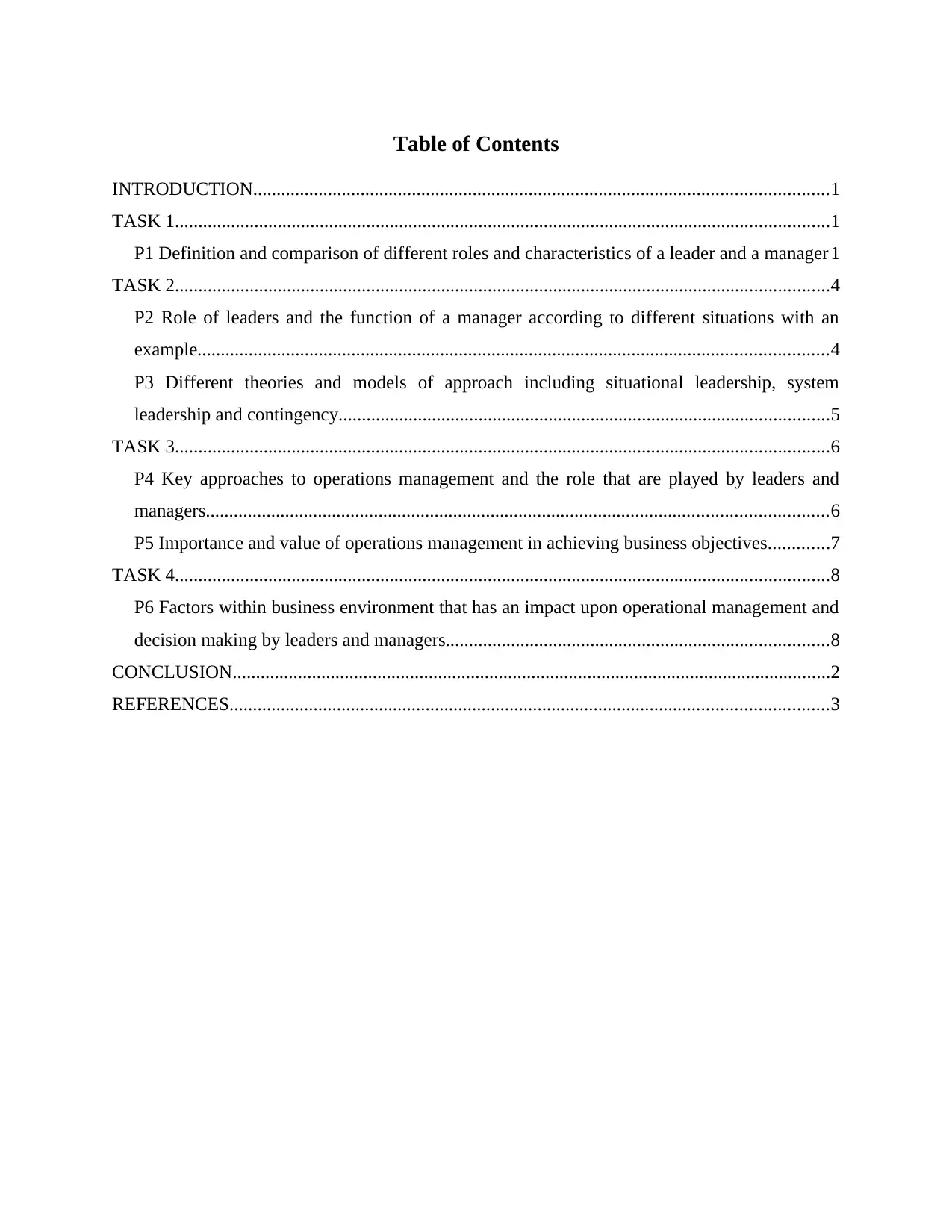
Table of Contents
INTRODUCTION...........................................................................................................................1
TASK 1............................................................................................................................................1
P1 Definition and comparison of different roles and characteristics of a leader and a manager 1
TASK 2............................................................................................................................................4
P2 Role of leaders and the function of a manager according to different situations with an
example.......................................................................................................................................4
P3 Different theories and models of approach including situational leadership, system
leadership and contingency.........................................................................................................5
TASK 3............................................................................................................................................6
P4 Key approaches to operations management and the role that are played by leaders and
managers.....................................................................................................................................6
P5 Importance and value of operations management in achieving business objectives.............7
TASK 4............................................................................................................................................8
P6 Factors within business environment that has an impact upon operational management and
decision making by leaders and managers..................................................................................8
CONCLUSION................................................................................................................................2
REFERENCES................................................................................................................................3
INTRODUCTION...........................................................................................................................1
TASK 1............................................................................................................................................1
P1 Definition and comparison of different roles and characteristics of a leader and a manager 1
TASK 2............................................................................................................................................4
P2 Role of leaders and the function of a manager according to different situations with an
example.......................................................................................................................................4
P3 Different theories and models of approach including situational leadership, system
leadership and contingency.........................................................................................................5
TASK 3............................................................................................................................................6
P4 Key approaches to operations management and the role that are played by leaders and
managers.....................................................................................................................................6
P5 Importance and value of operations management in achieving business objectives.............7
TASK 4............................................................................................................................................8
P6 Factors within business environment that has an impact upon operational management and
decision making by leaders and managers..................................................................................8
CONCLUSION................................................................................................................................2
REFERENCES................................................................................................................................3
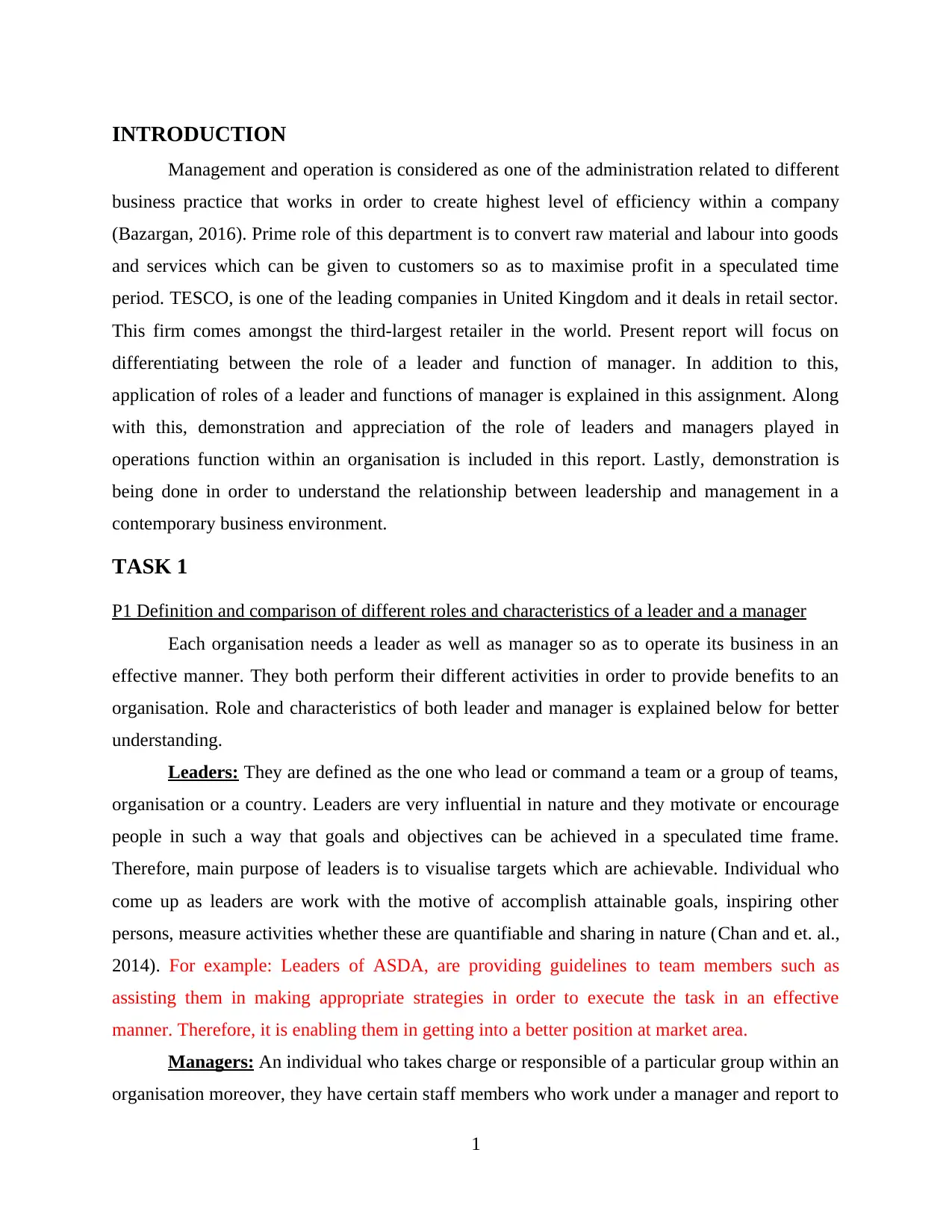
INTRODUCTION
Management and operation is considered as one of the administration related to different
business practice that works in order to create highest level of efficiency within a company
(Bazargan, 2016). Prime role of this department is to convert raw material and labour into goods
and services which can be given to customers so as to maximise profit in a speculated time
period. TESCO, is one of the leading companies in United Kingdom and it deals in retail sector.
This firm comes amongst the third-largest retailer in the world. Present report will focus on
differentiating between the role of a leader and function of manager. In addition to this,
application of roles of a leader and functions of manager is explained in this assignment. Along
with this, demonstration and appreciation of the role of leaders and managers played in
operations function within an organisation is included in this report. Lastly, demonstration is
being done in order to understand the relationship between leadership and management in a
contemporary business environment.
TASK 1
P1 Definition and comparison of different roles and characteristics of a leader and a manager
Each organisation needs a leader as well as manager so as to operate its business in an
effective manner. They both perform their different activities in order to provide benefits to an
organisation. Role and characteristics of both leader and manager is explained below for better
understanding.
Leaders: They are defined as the one who lead or command a team or a group of teams,
organisation or a country. Leaders are very influential in nature and they motivate or encourage
people in such a way that goals and objectives can be achieved in a speculated time frame.
Therefore, main purpose of leaders is to visualise targets which are achievable. Individual who
come up as leaders are work with the motive of accomplish attainable goals, inspiring other
persons, measure activities whether these are quantifiable and sharing in nature (Chan and et. al.,
2014). For example: Leaders of ASDA, are providing guidelines to team members such as
assisting them in making appropriate strategies in order to execute the task in an effective
manner. Therefore, it is enabling them in getting into a better position at market area.
Managers: An individual who takes charge or responsible of a particular group within an
organisation moreover, they have certain staff members who work under a manager and report to
1
Management and operation is considered as one of the administration related to different
business practice that works in order to create highest level of efficiency within a company
(Bazargan, 2016). Prime role of this department is to convert raw material and labour into goods
and services which can be given to customers so as to maximise profit in a speculated time
period. TESCO, is one of the leading companies in United Kingdom and it deals in retail sector.
This firm comes amongst the third-largest retailer in the world. Present report will focus on
differentiating between the role of a leader and function of manager. In addition to this,
application of roles of a leader and functions of manager is explained in this assignment. Along
with this, demonstration and appreciation of the role of leaders and managers played in
operations function within an organisation is included in this report. Lastly, demonstration is
being done in order to understand the relationship between leadership and management in a
contemporary business environment.
TASK 1
P1 Definition and comparison of different roles and characteristics of a leader and a manager
Each organisation needs a leader as well as manager so as to operate its business in an
effective manner. They both perform their different activities in order to provide benefits to an
organisation. Role and characteristics of both leader and manager is explained below for better
understanding.
Leaders: They are defined as the one who lead or command a team or a group of teams,
organisation or a country. Leaders are very influential in nature and they motivate or encourage
people in such a way that goals and objectives can be achieved in a speculated time frame.
Therefore, main purpose of leaders is to visualise targets which are achievable. Individual who
come up as leaders are work with the motive of accomplish attainable goals, inspiring other
persons, measure activities whether these are quantifiable and sharing in nature (Chan and et. al.,
2014). For example: Leaders of ASDA, are providing guidelines to team members such as
assisting them in making appropriate strategies in order to execute the task in an effective
manner. Therefore, it is enabling them in getting into a better position at market area.
Managers: An individual who takes charge or responsible of a particular group within an
organisation moreover, they have certain staff members who work under a manager and report to
1
⊘ This is a preview!⊘
Do you want full access?
Subscribe today to unlock all pages.

Trusted by 1+ million students worldwide
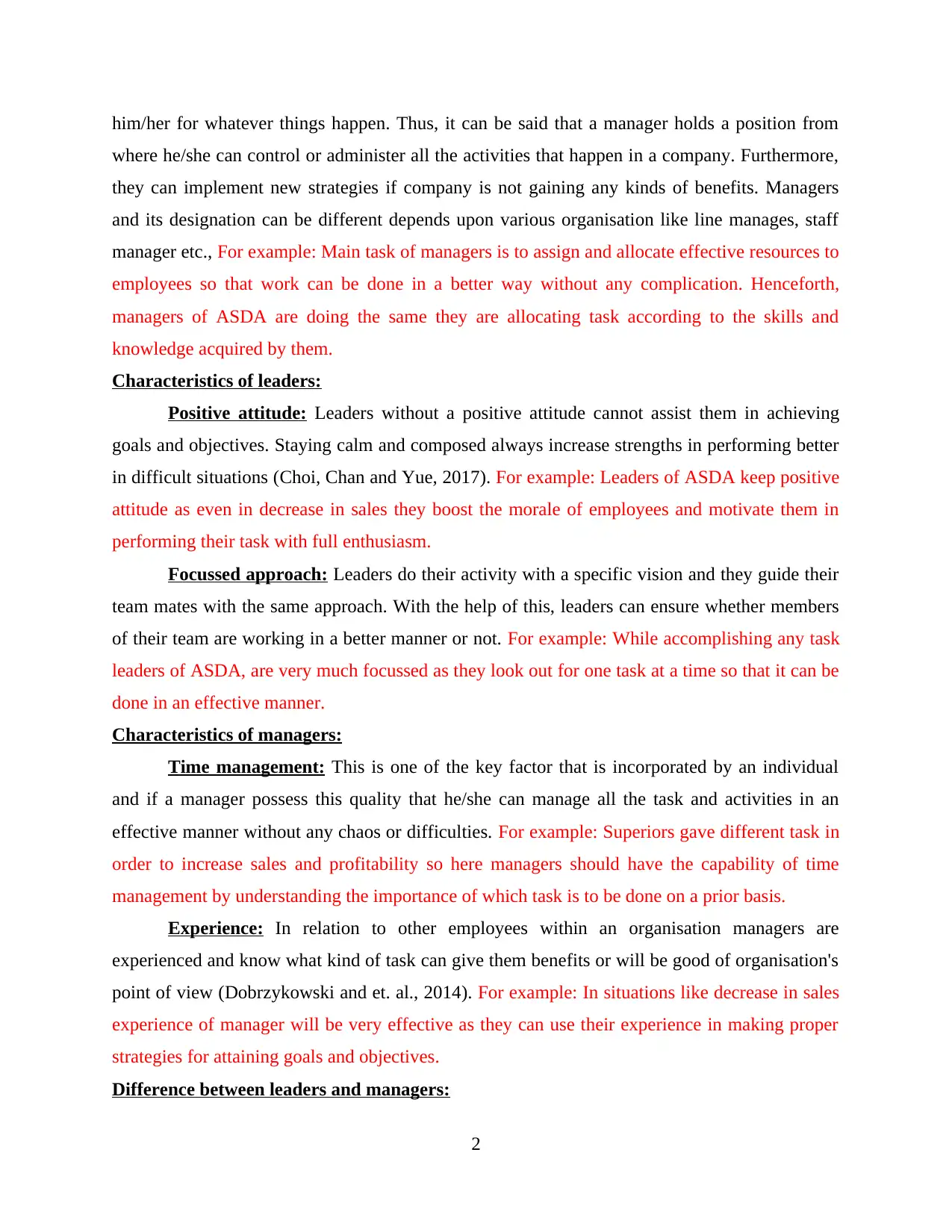
him/her for whatever things happen. Thus, it can be said that a manager holds a position from
where he/she can control or administer all the activities that happen in a company. Furthermore,
they can implement new strategies if company is not gaining any kinds of benefits. Managers
and its designation can be different depends upon various organisation like line manages, staff
manager etc., For example: Main task of managers is to assign and allocate effective resources to
employees so that work can be done in a better way without any complication. Henceforth,
managers of ASDA are doing the same they are allocating task according to the skills and
knowledge acquired by them.
Characteristics of leaders:
Positive attitude: Leaders without a positive attitude cannot assist them in achieving
goals and objectives. Staying calm and composed always increase strengths in performing better
in difficult situations (Choi, Chan and Yue, 2017). For example: Leaders of ASDA keep positive
attitude as even in decrease in sales they boost the morale of employees and motivate them in
performing their task with full enthusiasm.
Focussed approach: Leaders do their activity with a specific vision and they guide their
team mates with the same approach. With the help of this, leaders can ensure whether members
of their team are working in a better manner or not. For example: While accomplishing any task
leaders of ASDA, are very much focussed as they look out for one task at a time so that it can be
done in an effective manner.
Characteristics of managers:
Time management: This is one of the key factor that is incorporated by an individual
and if a manager possess this quality that he/she can manage all the task and activities in an
effective manner without any chaos or difficulties. For example: Superiors gave different task in
order to increase sales and profitability so here managers should have the capability of time
management by understanding the importance of which task is to be done on a prior basis.
Experience: In relation to other employees within an organisation managers are
experienced and know what kind of task can give them benefits or will be good of organisation's
point of view (Dobrzykowski and et. al., 2014). For example: In situations like decrease in sales
experience of manager will be very effective as they can use their experience in making proper
strategies for attaining goals and objectives.
Difference between leaders and managers:
2
where he/she can control or administer all the activities that happen in a company. Furthermore,
they can implement new strategies if company is not gaining any kinds of benefits. Managers
and its designation can be different depends upon various organisation like line manages, staff
manager etc., For example: Main task of managers is to assign and allocate effective resources to
employees so that work can be done in a better way without any complication. Henceforth,
managers of ASDA are doing the same they are allocating task according to the skills and
knowledge acquired by them.
Characteristics of leaders:
Positive attitude: Leaders without a positive attitude cannot assist them in achieving
goals and objectives. Staying calm and composed always increase strengths in performing better
in difficult situations (Choi, Chan and Yue, 2017). For example: Leaders of ASDA keep positive
attitude as even in decrease in sales they boost the morale of employees and motivate them in
performing their task with full enthusiasm.
Focussed approach: Leaders do their activity with a specific vision and they guide their
team mates with the same approach. With the help of this, leaders can ensure whether members
of their team are working in a better manner or not. For example: While accomplishing any task
leaders of ASDA, are very much focussed as they look out for one task at a time so that it can be
done in an effective manner.
Characteristics of managers:
Time management: This is one of the key factor that is incorporated by an individual
and if a manager possess this quality that he/she can manage all the task and activities in an
effective manner without any chaos or difficulties. For example: Superiors gave different task in
order to increase sales and profitability so here managers should have the capability of time
management by understanding the importance of which task is to be done on a prior basis.
Experience: In relation to other employees within an organisation managers are
experienced and know what kind of task can give them benefits or will be good of organisation's
point of view (Dobrzykowski and et. al., 2014). For example: In situations like decrease in sales
experience of manager will be very effective as they can use their experience in making proper
strategies for attaining goals and objectives.
Difference between leaders and managers:
2
Paraphrase This Document
Need a fresh take? Get an instant paraphrase of this document with our AI Paraphraser

BASIS Leaders Managers
Traits Leaders have ample number of
traits inherited within
themselves like honesty and
integrity, confidence, inspiring
others, commitment and
passion, they are consider as a
good communicator, in
addition to this, they have
effective decision making
qualities etc.,
With respect to leaders, an
outstanding manager evokes
certain traits and these are they
are creative in nature,
possessed knowledge, for
performing their activities they
have a set patterns or structure,
commitment and versatility
etc.,
Roles and Responsibilities A team leader's main role is to
provide directions along with
instructions and guidance.
Other than this, they tend to
maintain a proper coordination
amongst team members so that
they can work in collaboration
in order to achieve goals and
objectives in a limited time
frame. Leaders are suppose to
be a great communicator and
they use effective figure of
speech so that all the activities
can be understood by team
members. Apart from this,
leaders provide sufficient
resources and autonomy so
that goals and objectives can
be attained in a better manner.
Manager is the one who is
responsible for overseeing a
department or group of people
in an organisation. On the basis
of different business model
managers perform their certain
roles and responsibilities such
as performing daily operations,
staffing, setting goals,
administrations, enforcing
policies, providing training and
development programmes etc.
3
Traits Leaders have ample number of
traits inherited within
themselves like honesty and
integrity, confidence, inspiring
others, commitment and
passion, they are consider as a
good communicator, in
addition to this, they have
effective decision making
qualities etc.,
With respect to leaders, an
outstanding manager evokes
certain traits and these are they
are creative in nature,
possessed knowledge, for
performing their activities they
have a set patterns or structure,
commitment and versatility
etc.,
Roles and Responsibilities A team leader's main role is to
provide directions along with
instructions and guidance.
Other than this, they tend to
maintain a proper coordination
amongst team members so that
they can work in collaboration
in order to achieve goals and
objectives in a limited time
frame. Leaders are suppose to
be a great communicator and
they use effective figure of
speech so that all the activities
can be understood by team
members. Apart from this,
leaders provide sufficient
resources and autonomy so
that goals and objectives can
be attained in a better manner.
Manager is the one who is
responsible for overseeing a
department or group of people
in an organisation. On the basis
of different business model
managers perform their certain
roles and responsibilities such
as performing daily operations,
staffing, setting goals,
administrations, enforcing
policies, providing training and
development programmes etc.
3
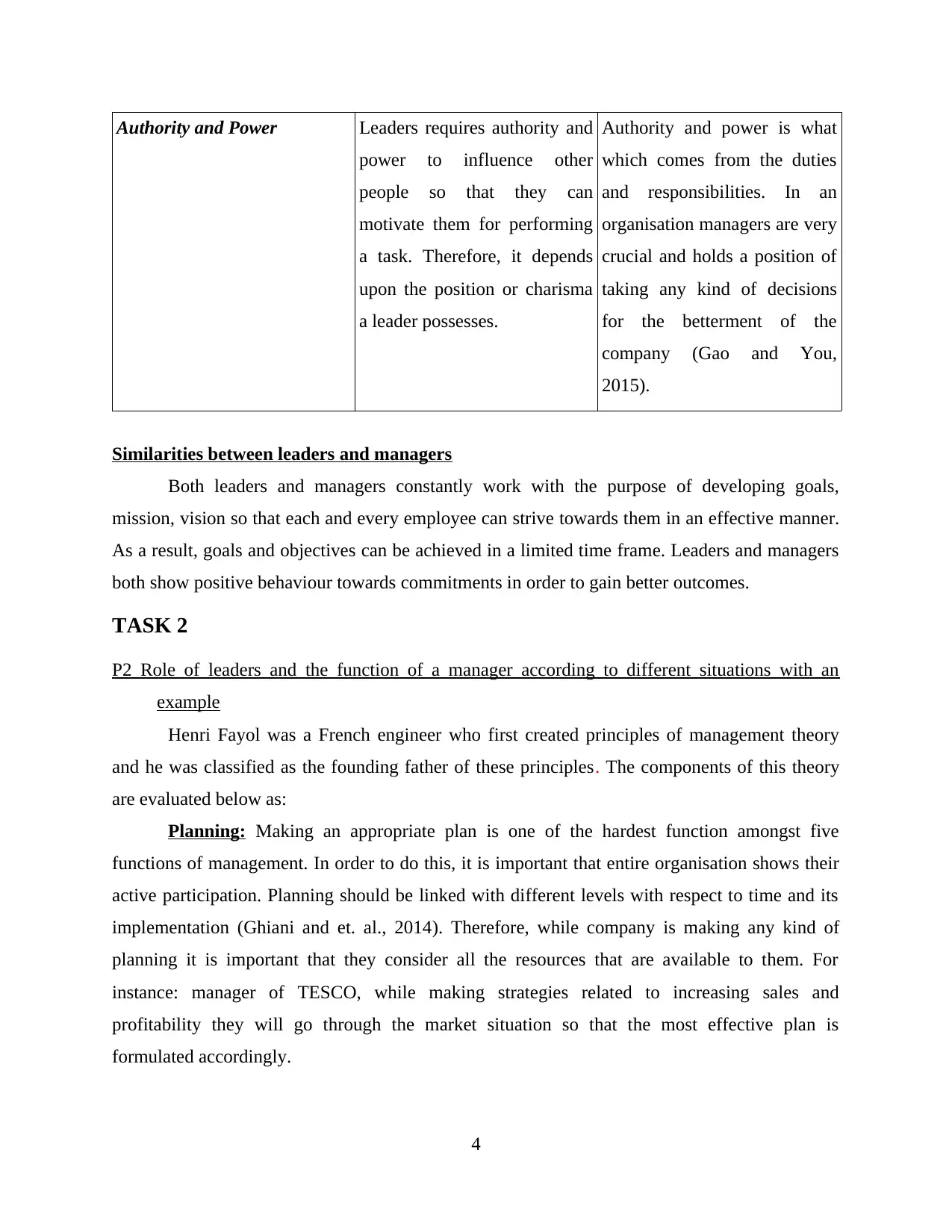
Authority and Power Leaders requires authority and
power to influence other
people so that they can
motivate them for performing
a task. Therefore, it depends
upon the position or charisma
a leader possesses.
Authority and power is what
which comes from the duties
and responsibilities. In an
organisation managers are very
crucial and holds a position of
taking any kind of decisions
for the betterment of the
company (Gao and You,
2015).
Similarities between leaders and managers
Both leaders and managers constantly work with the purpose of developing goals,
mission, vision so that each and every employee can strive towards them in an effective manner.
As a result, goals and objectives can be achieved in a limited time frame. Leaders and managers
both show positive behaviour towards commitments in order to gain better outcomes.
TASK 2
P2 Role of leaders and the function of a manager according to different situations with an
example
Henri Fayol was a French engineer who first created principles of management theory
and he was classified as the founding father of these principles. The components of this theory
are evaluated below as:
Planning: Making an appropriate plan is one of the hardest function amongst five
functions of management. In order to do this, it is important that entire organisation shows their
active participation. Planning should be linked with different levels with respect to time and its
implementation (Ghiani and et. al., 2014). Therefore, while company is making any kind of
planning it is important that they consider all the resources that are available to them. For
instance: manager of TESCO, while making strategies related to increasing sales and
profitability they will go through the market situation so that the most effective plan is
formulated accordingly.
4
power to influence other
people so that they can
motivate them for performing
a task. Therefore, it depends
upon the position or charisma
a leader possesses.
Authority and power is what
which comes from the duties
and responsibilities. In an
organisation managers are very
crucial and holds a position of
taking any kind of decisions
for the betterment of the
company (Gao and You,
2015).
Similarities between leaders and managers
Both leaders and managers constantly work with the purpose of developing goals,
mission, vision so that each and every employee can strive towards them in an effective manner.
As a result, goals and objectives can be achieved in a limited time frame. Leaders and managers
both show positive behaviour towards commitments in order to gain better outcomes.
TASK 2
P2 Role of leaders and the function of a manager according to different situations with an
example
Henri Fayol was a French engineer who first created principles of management theory
and he was classified as the founding father of these principles. The components of this theory
are evaluated below as:
Planning: Making an appropriate plan is one of the hardest function amongst five
functions of management. In order to do this, it is important that entire organisation shows their
active participation. Planning should be linked with different levels with respect to time and its
implementation (Ghiani and et. al., 2014). Therefore, while company is making any kind of
planning it is important that they consider all the resources that are available to them. For
instance: manager of TESCO, while making strategies related to increasing sales and
profitability they will go through the market situation so that the most effective plan is
formulated accordingly.
4
⊘ This is a preview!⊘
Do you want full access?
Subscribe today to unlock all pages.

Trusted by 1+ million students worldwide
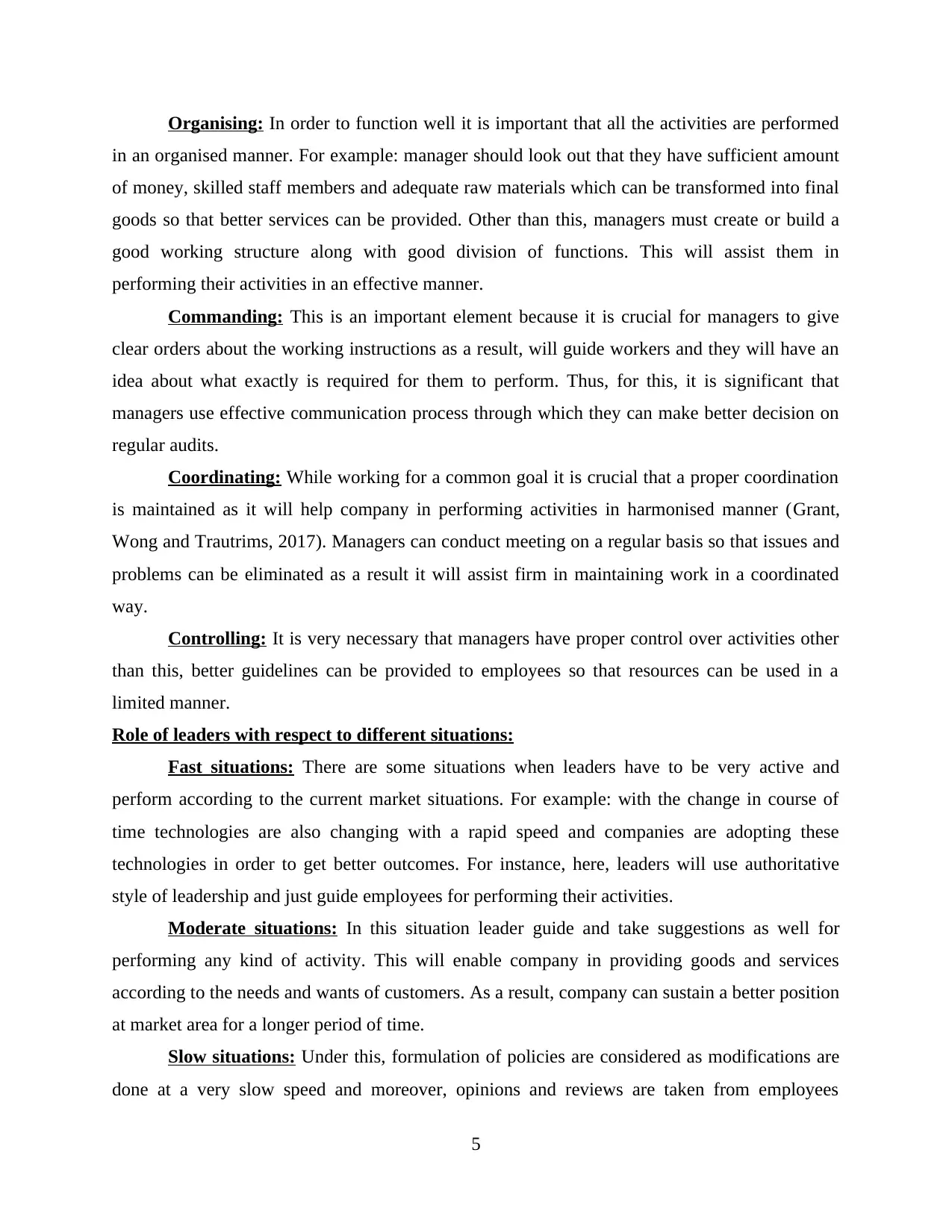
Organising: In order to function well it is important that all the activities are performed
in an organised manner. For example: manager should look out that they have sufficient amount
of money, skilled staff members and adequate raw materials which can be transformed into final
goods so that better services can be provided. Other than this, managers must create or build a
good working structure along with good division of functions. This will assist them in
performing their activities in an effective manner.
Commanding: This is an important element because it is crucial for managers to give
clear orders about the working instructions as a result, will guide workers and they will have an
idea about what exactly is required for them to perform. Thus, for this, it is significant that
managers use effective communication process through which they can make better decision on
regular audits.
Coordinating: While working for a common goal it is crucial that a proper coordination
is maintained as it will help company in performing activities in harmonised manner (Grant,
Wong and Trautrims, 2017). Managers can conduct meeting on a regular basis so that issues and
problems can be eliminated as a result it will assist firm in maintaining work in a coordinated
way.
Controlling: It is very necessary that managers have proper control over activities other
than this, better guidelines can be provided to employees so that resources can be used in a
limited manner.
Role of leaders with respect to different situations:
Fast situations: There are some situations when leaders have to be very active and
perform according to the current market situations. For example: with the change in course of
time technologies are also changing with a rapid speed and companies are adopting these
technologies in order to get better outcomes. For instance, here, leaders will use authoritative
style of leadership and just guide employees for performing their activities.
Moderate situations: In this situation leader guide and take suggestions as well for
performing any kind of activity. This will enable company in providing goods and services
according to the needs and wants of customers. As a result, company can sustain a better position
at market area for a longer period of time.
Slow situations: Under this, formulation of policies are considered as modifications are
done at a very slow speed and moreover, opinions and reviews are taken from employees
5
in an organised manner. For example: manager should look out that they have sufficient amount
of money, skilled staff members and adequate raw materials which can be transformed into final
goods so that better services can be provided. Other than this, managers must create or build a
good working structure along with good division of functions. This will assist them in
performing their activities in an effective manner.
Commanding: This is an important element because it is crucial for managers to give
clear orders about the working instructions as a result, will guide workers and they will have an
idea about what exactly is required for them to perform. Thus, for this, it is significant that
managers use effective communication process through which they can make better decision on
regular audits.
Coordinating: While working for a common goal it is crucial that a proper coordination
is maintained as it will help company in performing activities in harmonised manner (Grant,
Wong and Trautrims, 2017). Managers can conduct meeting on a regular basis so that issues and
problems can be eliminated as a result it will assist firm in maintaining work in a coordinated
way.
Controlling: It is very necessary that managers have proper control over activities other
than this, better guidelines can be provided to employees so that resources can be used in a
limited manner.
Role of leaders with respect to different situations:
Fast situations: There are some situations when leaders have to be very active and
perform according to the current market situations. For example: with the change in course of
time technologies are also changing with a rapid speed and companies are adopting these
technologies in order to get better outcomes. For instance, here, leaders will use authoritative
style of leadership and just guide employees for performing their activities.
Moderate situations: In this situation leader guide and take suggestions as well for
performing any kind of activity. This will enable company in providing goods and services
according to the needs and wants of customers. As a result, company can sustain a better position
at market area for a longer period of time.
Slow situations: Under this, formulation of policies are considered as modifications are
done at a very slow speed and moreover, opinions and reviews are taken from employees
5
Paraphrase This Document
Need a fresh take? Get an instant paraphrase of this document with our AI Paraphraser
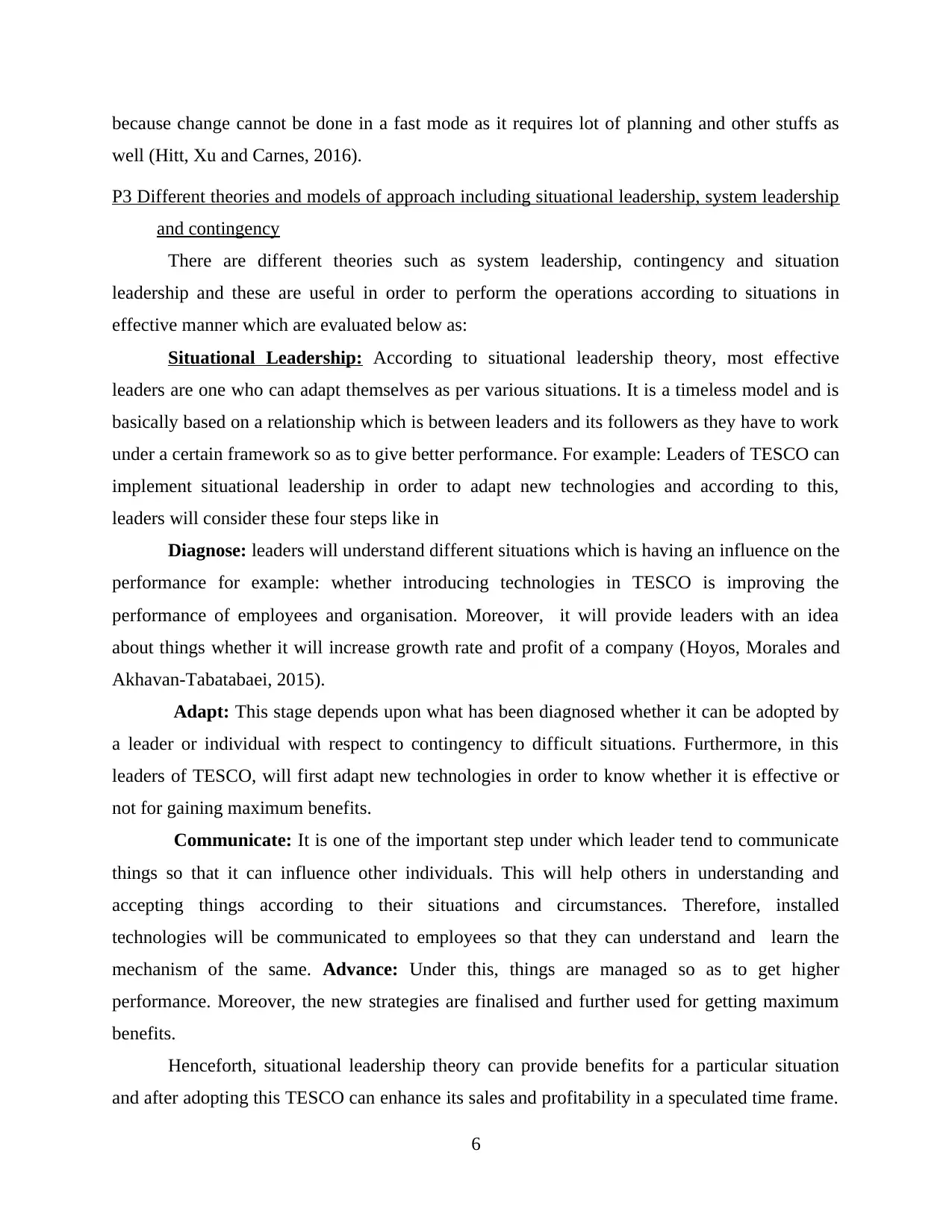
because change cannot be done in a fast mode as it requires lot of planning and other stuffs as
well (Hitt, Xu and Carnes, 2016).
P3 Different theories and models of approach including situational leadership, system leadership
and contingency
There are different theories such as system leadership, contingency and situation
leadership and these are useful in order to perform the operations according to situations in
effective manner which are evaluated below as:
Situational Leadership: According to situational leadership theory, most effective
leaders are one who can adapt themselves as per various situations. It is a timeless model and is
basically based on a relationship which is between leaders and its followers as they have to work
under a certain framework so as to give better performance. For example: Leaders of TESCO can
implement situational leadership in order to adapt new technologies and according to this,
leaders will consider these four steps like in
Diagnose: leaders will understand different situations which is having an influence on the
performance for example: whether introducing technologies in TESCO is improving the
performance of employees and organisation. Moreover, it will provide leaders with an idea
about things whether it will increase growth rate and profit of a company (Hoyos, Morales and
Akhavan-Tabatabaei, 2015).
Adapt: This stage depends upon what has been diagnosed whether it can be adopted by
a leader or individual with respect to contingency to difficult situations. Furthermore, in this
leaders of TESCO, will first adapt new technologies in order to know whether it is effective or
not for gaining maximum benefits.
Communicate: It is one of the important step under which leader tend to communicate
things so that it can influence other individuals. This will help others in understanding and
accepting things according to their situations and circumstances. Therefore, installed
technologies will be communicated to employees so that they can understand and learn the
mechanism of the same. Advance: Under this, things are managed so as to get higher
performance. Moreover, the new strategies are finalised and further used for getting maximum
benefits.
Henceforth, situational leadership theory can provide benefits for a particular situation
and after adopting this TESCO can enhance its sales and profitability in a speculated time frame.
6
well (Hitt, Xu and Carnes, 2016).
P3 Different theories and models of approach including situational leadership, system leadership
and contingency
There are different theories such as system leadership, contingency and situation
leadership and these are useful in order to perform the operations according to situations in
effective manner which are evaluated below as:
Situational Leadership: According to situational leadership theory, most effective
leaders are one who can adapt themselves as per various situations. It is a timeless model and is
basically based on a relationship which is between leaders and its followers as they have to work
under a certain framework so as to give better performance. For example: Leaders of TESCO can
implement situational leadership in order to adapt new technologies and according to this,
leaders will consider these four steps like in
Diagnose: leaders will understand different situations which is having an influence on the
performance for example: whether introducing technologies in TESCO is improving the
performance of employees and organisation. Moreover, it will provide leaders with an idea
about things whether it will increase growth rate and profit of a company (Hoyos, Morales and
Akhavan-Tabatabaei, 2015).
Adapt: This stage depends upon what has been diagnosed whether it can be adopted by
a leader or individual with respect to contingency to difficult situations. Furthermore, in this
leaders of TESCO, will first adapt new technologies in order to know whether it is effective or
not for gaining maximum benefits.
Communicate: It is one of the important step under which leader tend to communicate
things so that it can influence other individuals. This will help others in understanding and
accepting things according to their situations and circumstances. Therefore, installed
technologies will be communicated to employees so that they can understand and learn the
mechanism of the same. Advance: Under this, things are managed so as to get higher
performance. Moreover, the new strategies are finalised and further used for getting maximum
benefits.
Henceforth, situational leadership theory can provide benefits for a particular situation
and after adopting this TESCO can enhance its sales and profitability in a speculated time frame.
6
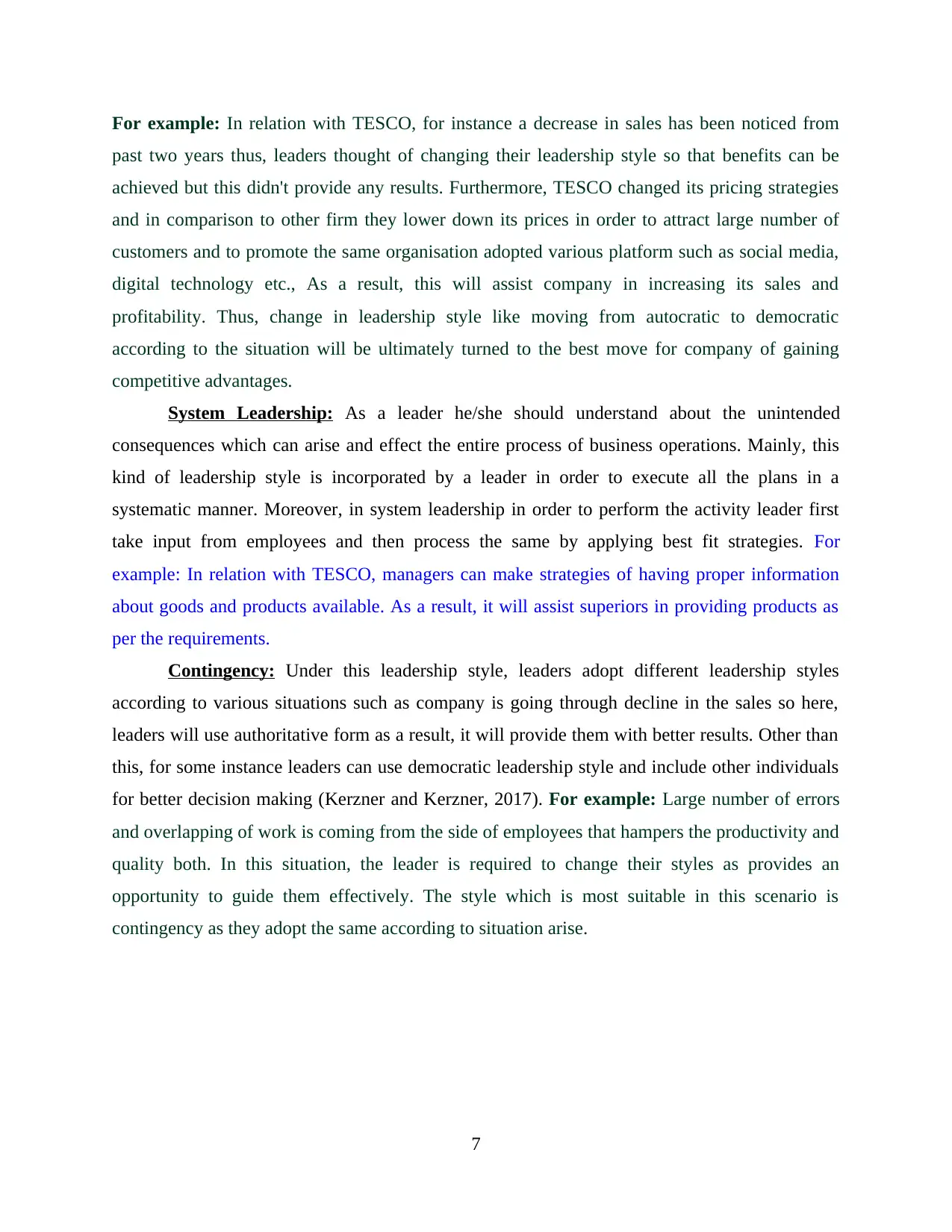
For example: In relation with TESCO, for instance a decrease in sales has been noticed from
past two years thus, leaders thought of changing their leadership style so that benefits can be
achieved but this didn't provide any results. Furthermore, TESCO changed its pricing strategies
and in comparison to other firm they lower down its prices in order to attract large number of
customers and to promote the same organisation adopted various platform such as social media,
digital technology etc., As a result, this will assist company in increasing its sales and
profitability. Thus, change in leadership style like moving from autocratic to democratic
according to the situation will be ultimately turned to the best move for company of gaining
competitive advantages.
System Leadership: As a leader he/she should understand about the unintended
consequences which can arise and effect the entire process of business operations. Mainly, this
kind of leadership style is incorporated by a leader in order to execute all the plans in a
systematic manner. Moreover, in system leadership in order to perform the activity leader first
take input from employees and then process the same by applying best fit strategies. For
example: In relation with TESCO, managers can make strategies of having proper information
about goods and products available. As a result, it will assist superiors in providing products as
per the requirements.
Contingency: Under this leadership style, leaders adopt different leadership styles
according to various situations such as company is going through decline in the sales so here,
leaders will use authoritative form as a result, it will provide them with better results. Other than
this, for some instance leaders can use democratic leadership style and include other individuals
for better decision making (Kerzner and Kerzner, 2017). For example: Large number of errors
and overlapping of work is coming from the side of employees that hampers the productivity and
quality both. In this situation, the leader is required to change their styles as provides an
opportunity to guide them effectively. The style which is most suitable in this scenario is
contingency as they adopt the same according to situation arise.
7
past two years thus, leaders thought of changing their leadership style so that benefits can be
achieved but this didn't provide any results. Furthermore, TESCO changed its pricing strategies
and in comparison to other firm they lower down its prices in order to attract large number of
customers and to promote the same organisation adopted various platform such as social media,
digital technology etc., As a result, this will assist company in increasing its sales and
profitability. Thus, change in leadership style like moving from autocratic to democratic
according to the situation will be ultimately turned to the best move for company of gaining
competitive advantages.
System Leadership: As a leader he/she should understand about the unintended
consequences which can arise and effect the entire process of business operations. Mainly, this
kind of leadership style is incorporated by a leader in order to execute all the plans in a
systematic manner. Moreover, in system leadership in order to perform the activity leader first
take input from employees and then process the same by applying best fit strategies. For
example: In relation with TESCO, managers can make strategies of having proper information
about goods and products available. As a result, it will assist superiors in providing products as
per the requirements.
Contingency: Under this leadership style, leaders adopt different leadership styles
according to various situations such as company is going through decline in the sales so here,
leaders will use authoritative form as a result, it will provide them with better results. Other than
this, for some instance leaders can use democratic leadership style and include other individuals
for better decision making (Kerzner and Kerzner, 2017). For example: Large number of errors
and overlapping of work is coming from the side of employees that hampers the productivity and
quality both. In this situation, the leader is required to change their styles as provides an
opportunity to guide them effectively. The style which is most suitable in this scenario is
contingency as they adopt the same according to situation arise.
7
⊘ This is a preview!⊘
Do you want full access?
Subscribe today to unlock all pages.

Trusted by 1+ million students worldwide
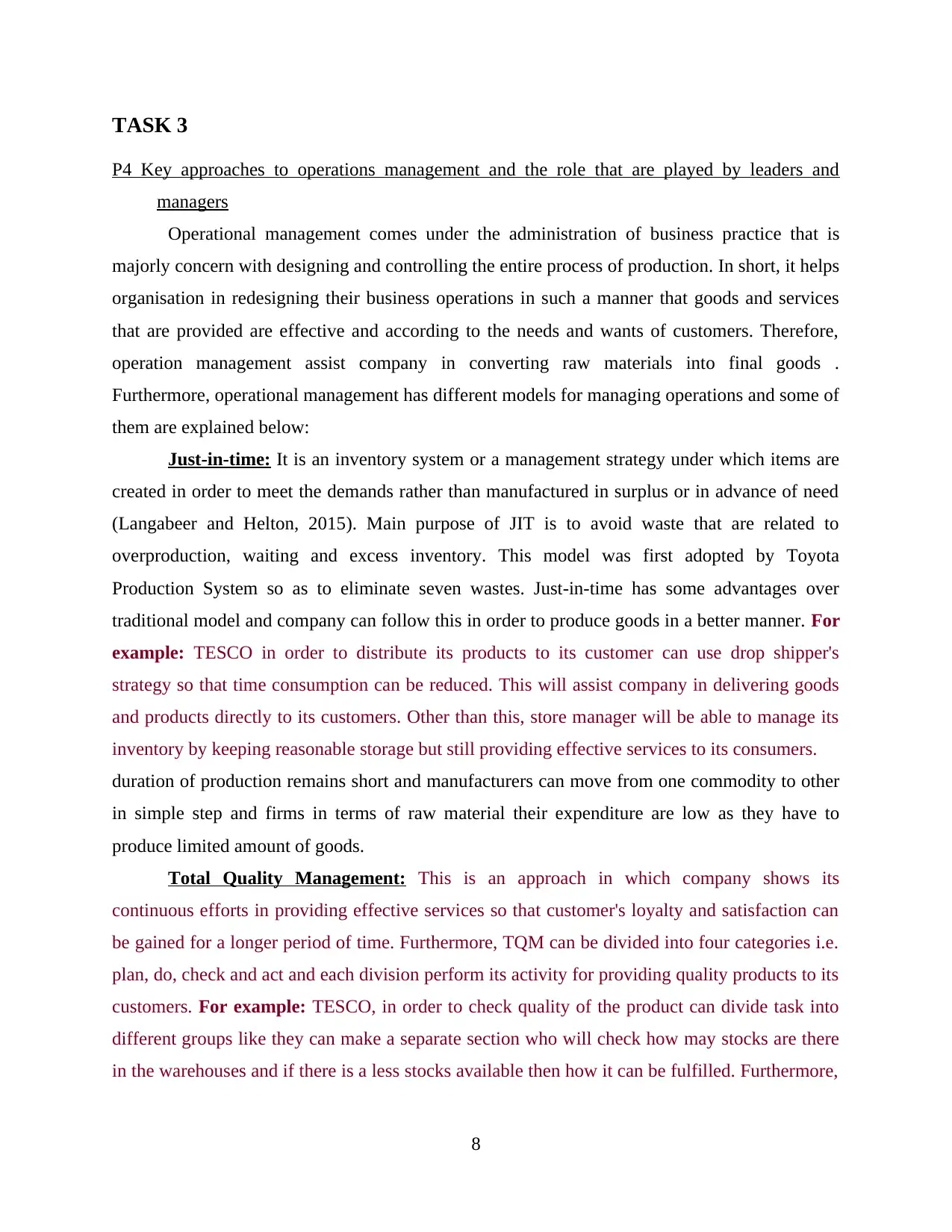
TASK 3
P4 Key approaches to operations management and the role that are played by leaders and
managers
Operational management comes under the administration of business practice that is
majorly concern with designing and controlling the entire process of production. In short, it helps
organisation in redesigning their business operations in such a manner that goods and services
that are provided are effective and according to the needs and wants of customers. Therefore,
operation management assist company in converting raw materials into final goods .
Furthermore, operational management has different models for managing operations and some of
them are explained below:
Just-in-time: It is an inventory system or a management strategy under which items are
created in order to meet the demands rather than manufactured in surplus or in advance of need
(Langabeer and Helton, 2015). Main purpose of JIT is to avoid waste that are related to
overproduction, waiting and excess inventory. This model was first adopted by Toyota
Production System so as to eliminate seven wastes. Just-in-time has some advantages over
traditional model and company can follow this in order to produce goods in a better manner. For
example: TESCO in order to distribute its products to its customer can use drop shipper's
strategy so that time consumption can be reduced. This will assist company in delivering goods
and products directly to its customers. Other than this, store manager will be able to manage its
inventory by keeping reasonable storage but still providing effective services to its consumers.
duration of production remains short and manufacturers can move from one commodity to other
in simple step and firms in terms of raw material their expenditure are low as they have to
produce limited amount of goods.
Total Quality Management: This is an approach in which company shows its
continuous efforts in providing effective services so that customer's loyalty and satisfaction can
be gained for a longer period of time. Furthermore, TQM can be divided into four categories i.e.
plan, do, check and act and each division perform its activity for providing quality products to its
customers. For example: TESCO, in order to check quality of the product can divide task into
different groups like they can make a separate section who will check how may stocks are there
in the warehouses and if there is a less stocks available then how it can be fulfilled. Furthermore,
8
P4 Key approaches to operations management and the role that are played by leaders and
managers
Operational management comes under the administration of business practice that is
majorly concern with designing and controlling the entire process of production. In short, it helps
organisation in redesigning their business operations in such a manner that goods and services
that are provided are effective and according to the needs and wants of customers. Therefore,
operation management assist company in converting raw materials into final goods .
Furthermore, operational management has different models for managing operations and some of
them are explained below:
Just-in-time: It is an inventory system or a management strategy under which items are
created in order to meet the demands rather than manufactured in surplus or in advance of need
(Langabeer and Helton, 2015). Main purpose of JIT is to avoid waste that are related to
overproduction, waiting and excess inventory. This model was first adopted by Toyota
Production System so as to eliminate seven wastes. Just-in-time has some advantages over
traditional model and company can follow this in order to produce goods in a better manner. For
example: TESCO in order to distribute its products to its customer can use drop shipper's
strategy so that time consumption can be reduced. This will assist company in delivering goods
and products directly to its customers. Other than this, store manager will be able to manage its
inventory by keeping reasonable storage but still providing effective services to its consumers.
duration of production remains short and manufacturers can move from one commodity to other
in simple step and firms in terms of raw material their expenditure are low as they have to
produce limited amount of goods.
Total Quality Management: This is an approach in which company shows its
continuous efforts in providing effective services so that customer's loyalty and satisfaction can
be gained for a longer period of time. Furthermore, TQM can be divided into four categories i.e.
plan, do, check and act and each division perform its activity for providing quality products to its
customers. For example: TESCO, in order to check quality of the product can divide task into
different groups like they can make a separate section who will check how may stocks are there
in the warehouses and if there is a less stocks available then how it can be fulfilled. Furthermore,
8
Paraphrase This Document
Need a fresh take? Get an instant paraphrase of this document with our AI Paraphraser
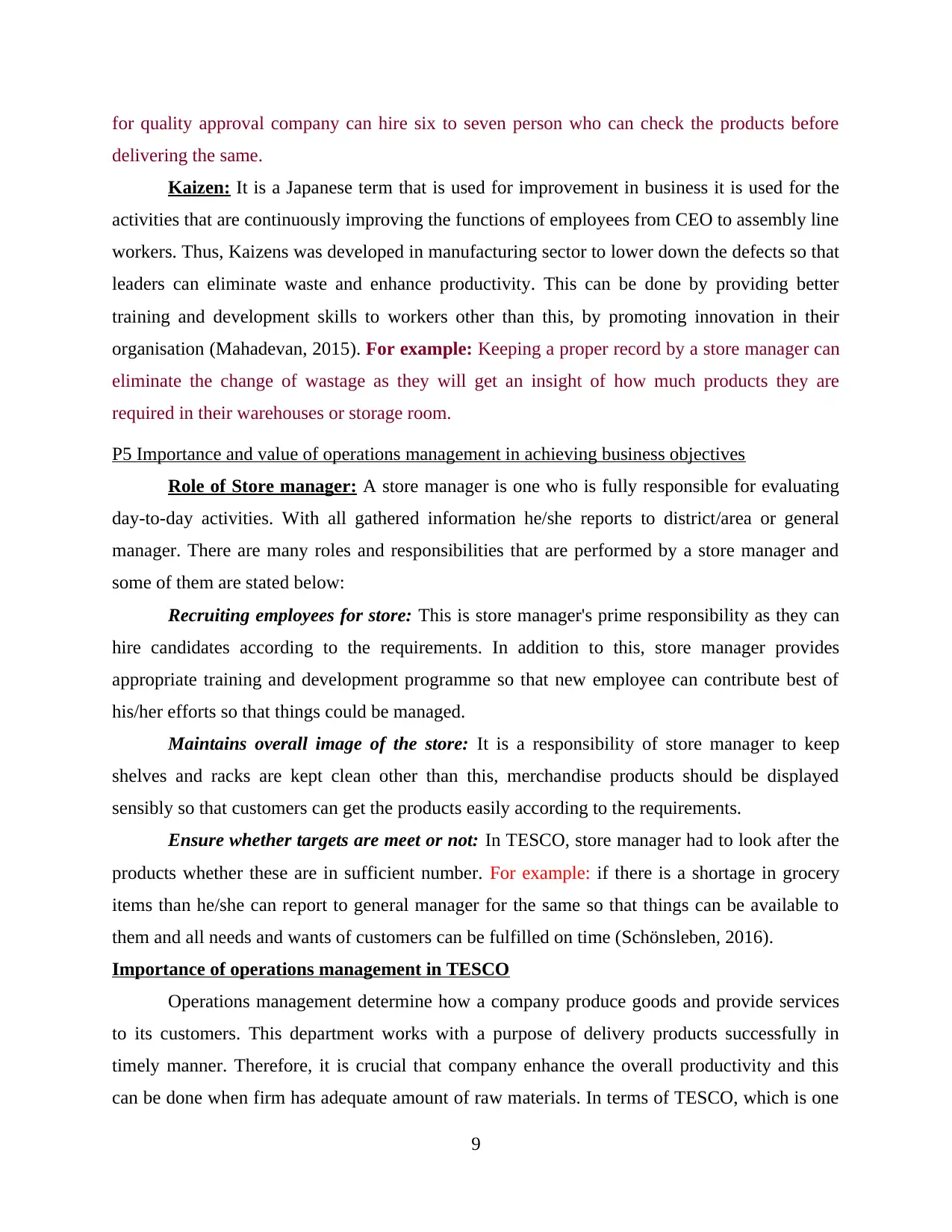
for quality approval company can hire six to seven person who can check the products before
delivering the same.
Kaizen: It is a Japanese term that is used for improvement in business it is used for the
activities that are continuously improving the functions of employees from CEO to assembly line
workers. Thus, Kaizens was developed in manufacturing sector to lower down the defects so that
leaders can eliminate waste and enhance productivity. This can be done by providing better
training and development skills to workers other than this, by promoting innovation in their
organisation (Mahadevan, 2015). For example: Keeping a proper record by a store manager can
eliminate the change of wastage as they will get an insight of how much products they are
required in their warehouses or storage room.
P5 Importance and value of operations management in achieving business objectives
Role of Store manager: A store manager is one who is fully responsible for evaluating
day-to-day activities. With all gathered information he/she reports to district/area or general
manager. There are many roles and responsibilities that are performed by a store manager and
some of them are stated below:
Recruiting employees for store: This is store manager's prime responsibility as they can
hire candidates according to the requirements. In addition to this, store manager provides
appropriate training and development programme so that new employee can contribute best of
his/her efforts so that things could be managed.
Maintains overall image of the store: It is a responsibility of store manager to keep
shelves and racks are kept clean other than this, merchandise products should be displayed
sensibly so that customers can get the products easily according to the requirements.
Ensure whether targets are meet or not: In TESCO, store manager had to look after the
products whether these are in sufficient number. For example: if there is a shortage in grocery
items than he/she can report to general manager for the same so that things can be available to
them and all needs and wants of customers can be fulfilled on time (Schönsleben, 2016).
Importance of operations management in TESCO
Operations management determine how a company produce goods and provide services
to its customers. This department works with a purpose of delivery products successfully in
timely manner. Therefore, it is crucial that company enhance the overall productivity and this
can be done when firm has adequate amount of raw materials. In terms of TESCO, which is one
9
delivering the same.
Kaizen: It is a Japanese term that is used for improvement in business it is used for the
activities that are continuously improving the functions of employees from CEO to assembly line
workers. Thus, Kaizens was developed in manufacturing sector to lower down the defects so that
leaders can eliminate waste and enhance productivity. This can be done by providing better
training and development skills to workers other than this, by promoting innovation in their
organisation (Mahadevan, 2015). For example: Keeping a proper record by a store manager can
eliminate the change of wastage as they will get an insight of how much products they are
required in their warehouses or storage room.
P5 Importance and value of operations management in achieving business objectives
Role of Store manager: A store manager is one who is fully responsible for evaluating
day-to-day activities. With all gathered information he/she reports to district/area or general
manager. There are many roles and responsibilities that are performed by a store manager and
some of them are stated below:
Recruiting employees for store: This is store manager's prime responsibility as they can
hire candidates according to the requirements. In addition to this, store manager provides
appropriate training and development programme so that new employee can contribute best of
his/her efforts so that things could be managed.
Maintains overall image of the store: It is a responsibility of store manager to keep
shelves and racks are kept clean other than this, merchandise products should be displayed
sensibly so that customers can get the products easily according to the requirements.
Ensure whether targets are meet or not: In TESCO, store manager had to look after the
products whether these are in sufficient number. For example: if there is a shortage in grocery
items than he/she can report to general manager for the same so that things can be available to
them and all needs and wants of customers can be fulfilled on time (Schönsleben, 2016).
Importance of operations management in TESCO
Operations management determine how a company produce goods and provide services
to its customers. This department works with a purpose of delivery products successfully in
timely manner. Therefore, it is crucial that company enhance the overall productivity and this
can be done when firm has adequate amount of raw materials. In terms of TESCO, which is one
9
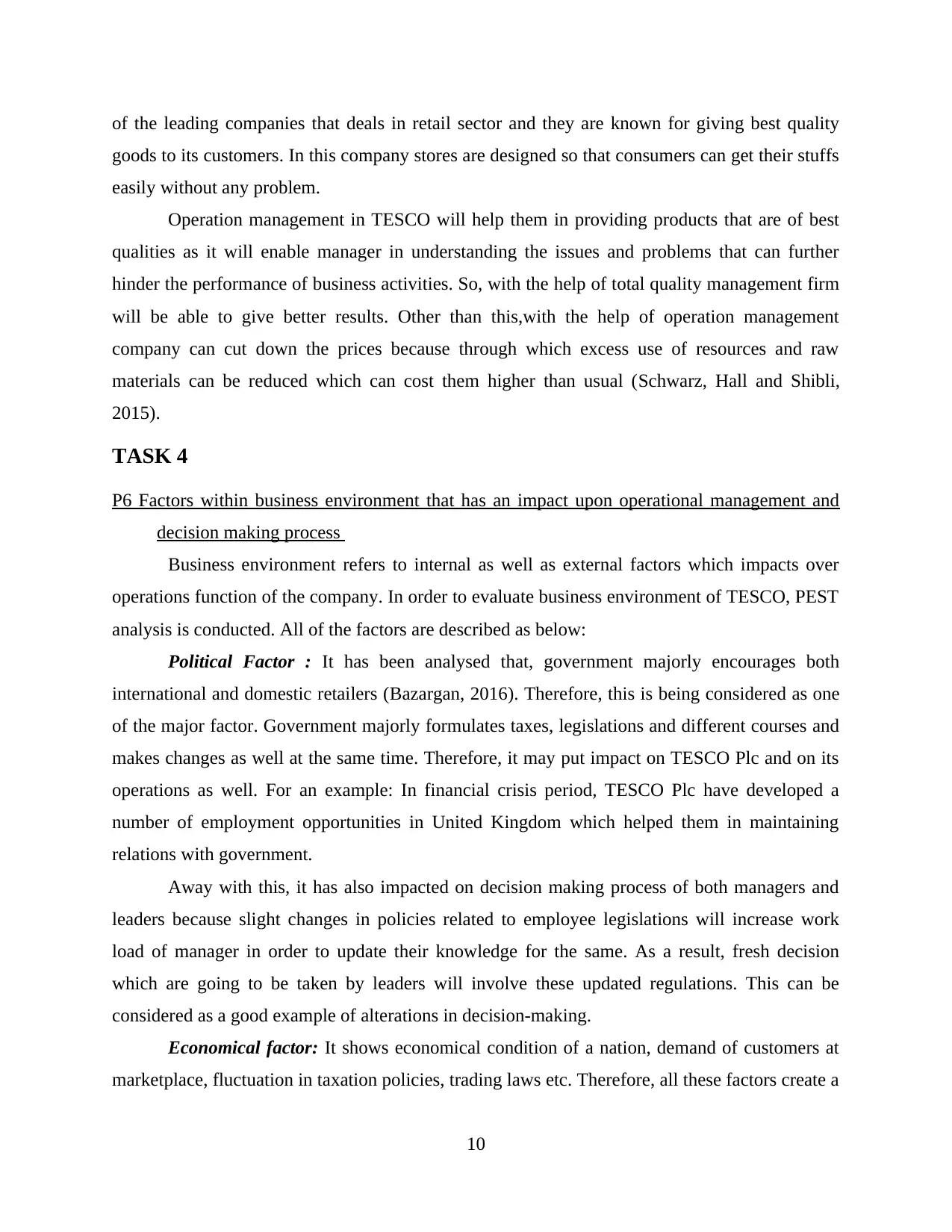
of the leading companies that deals in retail sector and they are known for giving best quality
goods to its customers. In this company stores are designed so that consumers can get their stuffs
easily without any problem.
Operation management in TESCO will help them in providing products that are of best
qualities as it will enable manager in understanding the issues and problems that can further
hinder the performance of business activities. So, with the help of total quality management firm
will be able to give better results. Other than this,with the help of operation management
company can cut down the prices because through which excess use of resources and raw
materials can be reduced which can cost them higher than usual (Schwarz, Hall and Shibli,
2015).
TASK 4
P6 Factors within business environment that has an impact upon operational management and
decision making process
Business environment refers to internal as well as external factors which impacts over
operations function of the company. In order to evaluate business environment of TESCO, PEST
analysis is conducted. All of the factors are described as below:
Political Factor : It has been analysed that, government majorly encourages both
international and domestic retailers (Bazargan, 2016). Therefore, this is being considered as one
of the major factor. Government majorly formulates taxes, legislations and different courses and
makes changes as well at the same time. Therefore, it may put impact on TESCO Plc and on its
operations as well. For an example: In financial crisis period, TESCO Plc have developed a
number of employment opportunities in United Kingdom which helped them in maintaining
relations with government.
Away with this, it has also impacted on decision making process of both managers and
leaders because slight changes in policies related to employee legislations will increase work
load of manager in order to update their knowledge for the same. As a result, fresh decision
which are going to be taken by leaders will involve these updated regulations. This can be
considered as a good example of alterations in decision-making.
Economical factor: It shows economical condition of a nation, demand of customers at
marketplace, fluctuation in taxation policies, trading laws etc. Therefore, all these factors create a
10
goods to its customers. In this company stores are designed so that consumers can get their stuffs
easily without any problem.
Operation management in TESCO will help them in providing products that are of best
qualities as it will enable manager in understanding the issues and problems that can further
hinder the performance of business activities. So, with the help of total quality management firm
will be able to give better results. Other than this,with the help of operation management
company can cut down the prices because through which excess use of resources and raw
materials can be reduced which can cost them higher than usual (Schwarz, Hall and Shibli,
2015).
TASK 4
P6 Factors within business environment that has an impact upon operational management and
decision making process
Business environment refers to internal as well as external factors which impacts over
operations function of the company. In order to evaluate business environment of TESCO, PEST
analysis is conducted. All of the factors are described as below:
Political Factor : It has been analysed that, government majorly encourages both
international and domestic retailers (Bazargan, 2016). Therefore, this is being considered as one
of the major factor. Government majorly formulates taxes, legislations and different courses and
makes changes as well at the same time. Therefore, it may put impact on TESCO Plc and on its
operations as well. For an example: In financial crisis period, TESCO Plc have developed a
number of employment opportunities in United Kingdom which helped them in maintaining
relations with government.
Away with this, it has also impacted on decision making process of both managers and
leaders because slight changes in policies related to employee legislations will increase work
load of manager in order to update their knowledge for the same. As a result, fresh decision
which are going to be taken by leaders will involve these updated regulations. This can be
considered as a good example of alterations in decision-making.
Economical factor: It shows economical condition of a nation, demand of customers at
marketplace, fluctuation in taxation policies, trading laws etc. Therefore, all these factors create a
10
⊘ This is a preview!⊘
Do you want full access?
Subscribe today to unlock all pages.

Trusted by 1+ million students worldwide
1 out of 14
Related Documents
Your All-in-One AI-Powered Toolkit for Academic Success.
+13062052269
info@desklib.com
Available 24*7 on WhatsApp / Email
![[object Object]](/_next/static/media/star-bottom.7253800d.svg)
Unlock your academic potential
Copyright © 2020–2025 A2Z Services. All Rights Reserved. Developed and managed by ZUCOL.





